Linux下查看某目录或指定文件大小的命令
Linux命令高级技巧使用du命令查看文件与的磁盘使用情况
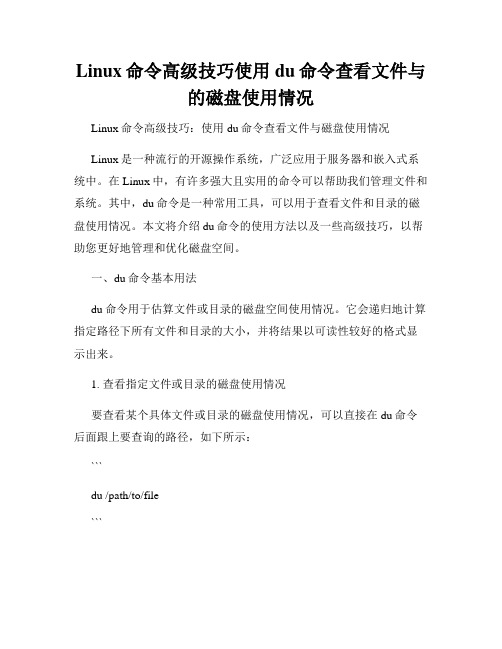
Linux命令高级技巧使用du命令查看文件与的磁盘使用情况Linux命令高级技巧:使用du命令查看文件与磁盘使用情况Linux是一种流行的开源操作系统,广泛应用于服务器和嵌入式系统中。
在Linux中,有许多强大且实用的命令可以帮助我们管理文件和系统。
其中,du命令是一种常用工具,可以用于查看文件和目录的磁盘使用情况。
本文将介绍du命令的使用方法以及一些高级技巧,以帮助您更好地管理和优化磁盘空间。
一、du命令基本用法du命令用于估算文件或目录的磁盘空间使用情况。
它会递归地计算指定路径下所有文件和目录的大小,并将结果以可读性较好的格式显示出来。
1. 查看指定文件或目录的磁盘使用情况要查看某个具体文件或目录的磁盘使用情况,可以直接在du命令后面跟上要查询的路径,如下所示:```du /path/to/file```2. 默认情况下,du命令将以字节为单位显示文件和目录的大小。
为了更好地阅读,可以使用-h选项以人类可读的方式显示结果,如下所示:```du -h /path/to/file```3. 如果要查看某个目录下所有文件和子目录的磁盘使用情况,可以将目录路径作为du命令的参数。
例如,要查看根目录下所有文件和目录的磁盘使用情况,可以运行以下命令:```du -h /```二、du命令高级技巧除了基本的用法之外,du命令还提供了一些高级技巧,可以帮助我们更详细地分析文件和目录的磁盘使用情况。
1. 限制du命令的递归深度通过使用--max-depth选项,我们可以限制du命令的递归深度,从而只显示指定层级的文件和目录的磁盘使用情况。
例如,以下命令将限制du命令的递归深度为2,并显示根目录下所有文件和目录的磁盘使用情况:```du -h --max-depth=2 /```2. 排除指定文件或目录有时候,我们可能希望在计算磁盘使用情况时排除某个特定的文件或目录。
du命令提供了--exclude选项,用于指定要排除的文件或目录的模式。
linux下使用du查看某个文件或目录占用磁盘空间的大小方法
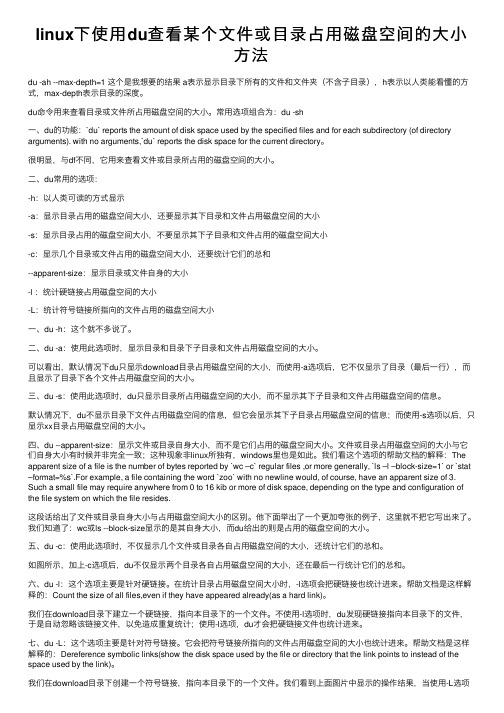
linux下使⽤du查看某个⽂件或⽬录占⽤磁盘空间的⼤⼩⽅法du -ah --max-depth=1 这个是我想要的结果 a表⽰显⽰⽬录下所有的⽂件和⽂件夹(不含⼦⽬录),h表⽰以⼈类能看懂的⽅式,max-depth表⽰⽬录的深度。
du命令⽤来查看⽬录或⽂件所占⽤磁盘空间的⼤⼩。
常⽤选项组合为:du -sh⼀、du的功能:`du` reports the amount of disk space used by the specified files and for each subdirectory (of directory arguments). with no arguments,`du` reports the disk space for the current directory。
很明显,与df不同,它⽤来查看⽂件或⽬录所占⽤的磁盘空间的⼤⼩。
⼆、du常⽤的选项:-h:以⼈类可读的⽅式显⽰-a:显⽰⽬录占⽤的磁盘空间⼤⼩,还要显⽰其下⽬录和⽂件占⽤磁盘空间的⼤⼩-s:显⽰⽬录占⽤的磁盘空间⼤⼩,不要显⽰其下⼦⽬录和⽂件占⽤的磁盘空间⼤⼩-c:显⽰⼏个⽬录或⽂件占⽤的磁盘空间⼤⼩,还要统计它们的总和--apparent-size:显⽰⽬录或⽂件⾃⾝的⼤⼩-l :统计硬链接占⽤磁盘空间的⼤⼩-L:统计符号链接所指向的⽂件占⽤的磁盘空间⼤⼩⼀、du -h:这个就不多说了。
⼆、du -a:使⽤此选项时,显⽰⽬录和⽬录下⼦⽬录和⽂件占⽤磁盘空间的⼤⼩。
可以看出,默认情况下du只显⽰download⽬录占⽤磁盘空间的⼤⼩,⽽使⽤-a选项后,它不仅显⽰了⽬录(最后⼀⾏),⽽且显⽰了⽬录下各个⽂件占⽤磁盘空间的⼤⼩。
三、du -s:使⽤此选项时,du只显⽰⽬录所占⽤磁盘空间的⼤⼩,⽽不显⽰其下⼦⽬录和⽂件占⽤磁盘空间的信息。
默认情况下,du不显⽰⽬录下⽂件占⽤磁盘空间的信息,但它会显⽰其下⼦⽬录占⽤磁盘空间的信息;⽽使⽤-s选项以后,只显⽰xx⽬录占⽤磁盘空间的⼤⼩。
linux命令-查看当前目录下所有文件的大小:“ll-h”
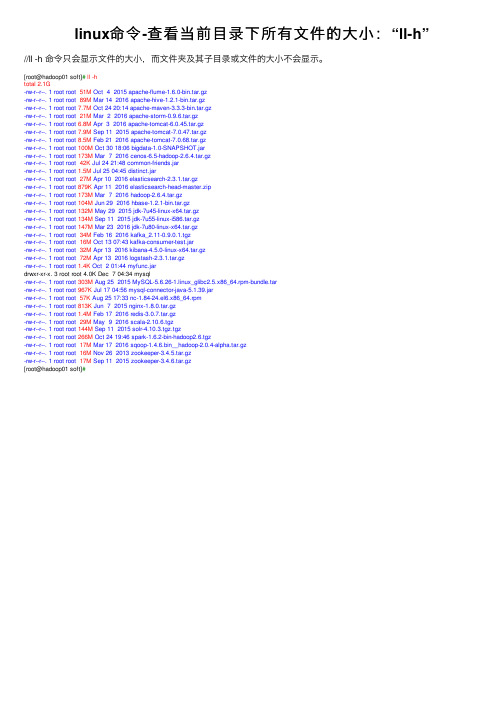
linux命令-查看当前⽬录下所有⽂件的⼤⼩:“ll-h”//ll -h 命令只会显⽰⽂件的⼤⼩,⽽⽂件夹及其⼦⽬录或⽂件的⼤⼩不会显⽰。
[root@hadoop01 soft]# ll -htotal 2.1G-rw-r--r--. 1 root root 51M Oct 4 2015 apache-flume-1.6.0-bin.tar.gz-rw-r--r--. 1 root root 89M Mar 14 2016 apache-hive-1.2.1-bin.tar.gz-rw-r--r--. 1 root root 7.7M Oct 24 20:14 apache-maven-3.3.3-bin.tar.gz-rw-r--r--. 1 root root 21M Mar 2 2016 apache-storm-0.9.6.tar.gz-rw-r--r--. 1 root root 6.8M Apr 3 2016 apache-tomcat-6.0.45.tar.gz-rw-r--r--. 1 root root 7.9M Sep 11 2015 apache-tomcat-7.0.47.tar.gz-rw-r--r--. 1 root root 8.5M Feb 21 2016 apache-tomcat-7.0.68.tar.gz-rw-r--r--. 1 root root 100M Oct 30 18:06 bigdata-1.0-SNAPSHOT.jar-rw-r--r--. 1 root root 173M Mar 7 2016 cenos-6.5-hadoop-2.6.4.tar.gz-rw-r--r--. 1 root root 42K Jul 24 21:48 common-friends.jar-rw-r--r--. 1 root root 1.5M Jul 25 04:45 distinct.jar-rw-r--r--. 1 root root 27M Apr 10 2016 elasticsearch-2.3.1.tar.gz-rw-r--r--. 1 root root 879K Apr 11 2016 elasticsearch-head-master.zip-rw-r--r--. 1 root root 173M Mar 7 2016 hadoop-2.6.4.tar.gz-rw-r--r--. 1 root root 104M Jun 29 2016 hbase-1.2.1-bin.tar.gz-rw-r--r--. 1 root root 132M May 29 2015 jdk-7u45-linux-x64.tar.gz-rw-r--r--. 1 root root 134M Sep 11 2015 jdk-7u55-linux-i586.tar.gz-rw-r--r--. 1 root root 147M Mar 23 2016 jdk-7u80-linux-x64.tar.gz-rw-r--r--. 1 root root 34M Feb 16 2016 kafka_2.11-0.9.0.1.tgz-rw-r--r--. 1 root root 16M Oct 13 07:43 kafka-consumer-test.jar-rw-r--r--. 1 root root 32M Apr 13 2016 kibana-4.5.0-linux-x64.tar.gz-rw-r--r--. 1 root root 72M Apr 13 2016 logstash-2.3.1.tar.gz-rw-r--r--. 1 root root 1.4K Oct 2 01:44 myfunc.jardrwxr-xr-x. 3 root root 4.0K Dec 7 04:34 mysql-rw-r--r--. 1 root root 303M Aug 25 2015 MySQL-5.6.26-1.linux_glibc2.5.x86_64.rpm-bundle.tar-rw-r--r--. 1 root root 967K Jul 17 04:56 mysql-connector-java-5.1.39.jar-rw-r--r--. 1 root root 57K Aug 25 17:33 nc-1.84-24.el6.x86_64.rpm-rw-r--r--. 1 root root 813K Jun 7 2015 nginx-1.8.0.tar.gz-rw-r--r--. 1 root root 1.4M Feb 17 2016 redis-3.0.7.tar.gz-rw-r--r--. 1 root root 29M May 9 2016 scala-2.10.6.tgz-rw-r--r--. 1 root root 144M Sep 11 2015 solr-4.10.3.tgz.tgz-rw-r--r--. 1 root root 266M Oct 24 19:46 spark-1.6.2-bin-hadoop2.6.tgz-rw-r--r--. 1 root root 17M Mar 17 2016 sqoop-1.4.6.bin__hadoop-2.0.4-alpha.tar.gz-rw-r--r--. 1 root root 16M Nov 26 2013 zookeeper-3.4.5.tar.gz-rw-r--r--. 1 root root 17M Sep 11 2015 zookeeper-3.4.6.tar.gz[root@hadoop01 soft]#。
Linux上查找最大文件的3种方法
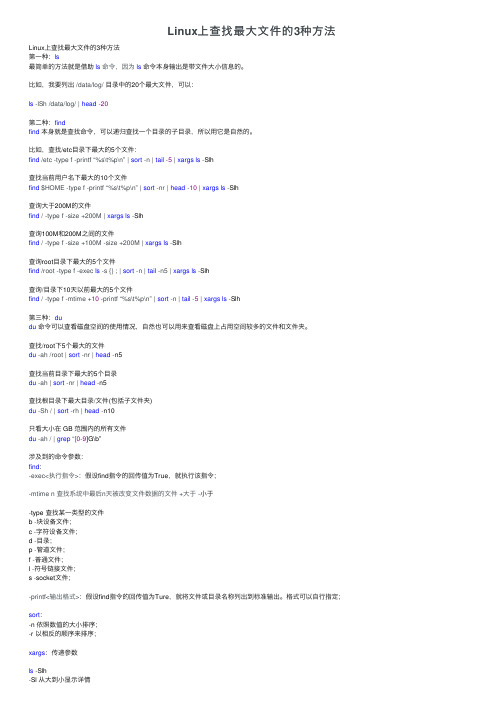
Linux上查找最⼤⽂件的3种⽅法Linux上查找最⼤⽂件的3种⽅法第⼀种:ls最简单的⽅法就是借助ls命令,因为ls命令本⾝输出是带⽂件⼤⼩信息的。
⽐如,我要列出/data/log/⽬录中的20个最⼤⽂件,可以:ls -lSh /data/log/ | head -20第⼆种:findfind本⾝就是查找命令,可以递归查找⼀个⽬录的⼦⽬录,所以⽤它是⾃然的。
⽐如,查找/etc⽬录下最⼤的5个⽂件:find /etc -type f -printf “%s\t%p\n” | sort -n | tail -5 | xargs ls -Slh查找当前⽤户名下最⼤的10个⽂件find $HOME -type f -printf “%s\t%p\n” | sort -nr | head -10 | xargs ls -Slh查询⼤于200M的⽂件find / -type f -size +200M | xargs ls -Slh查询100M和200M之间的⽂件find / -type f -size +100M -size +200M | xargs ls -Slh查询root⽬录下最⼤的5个⽂件find /root -type f -exec ls -s {} ; | sort -n | tail -n5 | xargs ls -Slh查询/⽬录下10天以前最⼤的5个⽂件find / -type f -mtime +10 -printf “%s\t%p\n” | sort -n | tail -5 | xargs ls -Slh第三种:dudu命令可以查看磁盘空间的使⽤情况,⾃然也可以⽤来查看磁盘上占⽤空间较多的⽂件和⽂件夹。
查找/root下5个最⼤的⽂件du -ah /root | sort -nr | head -n5查找当前⽬录下最⼤的5个⽬录du -ah | sort -nr | head -n5查找根⽬录下最⼤⽬录/⽂件(包括⼦⽂件夹)du -Sh / | sort -rh | head -n10只看⼤⼩在 GB 范围内的所有⽂件du -ah / | grep “[0-9]G\b”涉及到的命令参数:find:-exec<执⾏指令>:假设find指令的回传值为True,就执⾏该指令;-mtime n 查找系统中最后n天被改变⽂件数据的⽂件 +⼤于 -⼩于-type 查找某⼀类型的⽂件b -块设备⽂件;c -字符设备⽂件;d -⽬录;p -管道⽂件;f -普通⽂件;l -符号链接⽂件;s -socket⽂件;-printf<输出格式>:假设find指令的回传值为Ture,就将⽂件或⽬录名称列出到标准输出。
linux_中查看文件大小的命令_概述及解释说明

linux 中查看文件大小的命令概述及解释说明1. 引言1.1 概述在Linux操作系统中,了解如何查看文件大小是一项基本的技能。
文件大小是指一个文件所占用的存储空间大小,它通常以字节为单位表示。
通过查看文件大小,我们可以了解到各个文件的占用空间情况,从而对系统磁盘使用情况进行监控和管理。
本文将主要介绍Linux中查看文件大小的命令,并详细解释和说明这些命令的用法和功能。
通过学习并掌握这些命令,读者将能够轻松地获取文件大小信息,并获得对系统磁盘使用情况进行优化和调整的能力。
1.2 文章结构本文分为五个主要部分:引言、linux中查看文件大小的命令、命令解释与示例说明、实际应用场景分析以及结论。
- 引言部分将简单概述本文涉及的主题内容,并介绍文章结构。
- linux中查看文件大小的命令部分将介绍Linux操作系统中用于查看文件大小的常见命令,包括du、ls和find等。
- 命令解释与示例说明部分将详细解释每个命令的功能和用法,并提供一些示例来帮助读者更好地理解。
- 实际应用场景分析部分将通过具体的应用场景,展示这些命令在实际情况下的应用价值,并给出相应的建议和优化策略。
- 结论部分将对本文的主要内容进行总结,并提供个人观点(可选)。
1.3 目的本文的目的是帮助读者全面了解Linux中查看文件大小的命令,并掌握其使用方法。
通过学习这些命令,读者将能够有效地管理系统磁盘空间,优化文件清理和压缩策略,并提高系统性能。
无论是初学者还是有一定经验的Linux用户,都能从本文中获得有益的知识和技巧。
2. linux中查看文件大小的命令2.1 文件管理系统简介在Linux操作系统中,文件是系统中最基本的单位之一。
文件有不同的大小,通常以字节为单位来表示。
了解如何查看文件大小是管理文件和磁盘空间非常重要的一部分。
2.2 查看文件大小的常用命令在Linux系统中,有几个常用的命令可以用来查看文件的大小。
- du命令:该命令用于估算指定目录或文件所占用磁盘空间的大小。
Linux文件内容查看常用命令
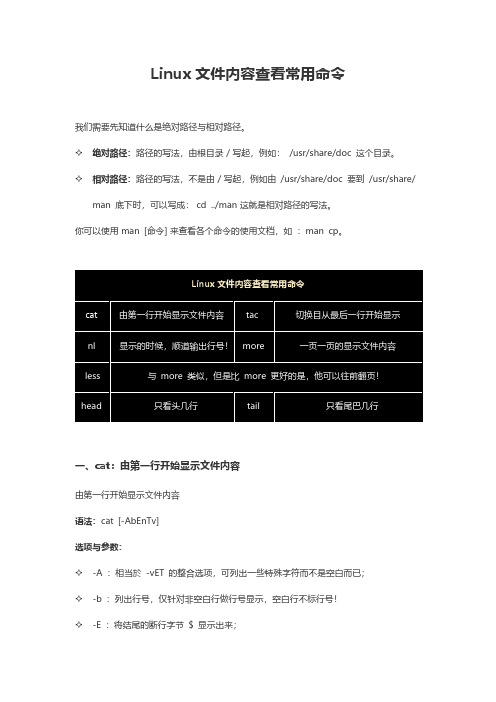
✧-n:列印出行号,连同空白行也会有行号,与-b的选项不同;✧-T:将[tab]按键以^I显示出来;✧-v:列出一些看不出来的特殊字符检看/etc/issue这个文件的内容:cat/etc/issue二、tac:切换目从最后一行开始显示tac与cat命令刚好相反,文件内容从最后一行开始显示,可以看出tac是cat的倒着写!如:tac/etc/issue三、nl:显示的时候,顺道输出行号显示行号语法:nl[-bnw]文件选项与参数:✧-b:指定行号指定的方式,主要有两种:✧-b a:表示不论是否为空行,也同样列出行号(类似cat-n);✧-b t:如果有空行,空的那一行不要列出行号(默认值);✧-n:列出行号表示的方法,主要有三种:✧-n ln:行号在荧幕的最左方显示;✧-n rn:行号在自己栏位的最右方显示,且不加0;✧-n rz:行号在自己栏位的最右方显示,且加0;✧-w:行号栏位的占用的位数。
实例一:用nl列出/etc/issue的内容nl/etc/issue四、more:一页一页的显示文件内容一页一页翻动,在more这个程序的运行过程中,你有几个按键可以按的:✧空白键(space):代表向下翻一页;✧Enter:代表向下翻『一行』;✧/字串:代表在这个显示的内容当中,向下搜寻『字串』这个关键字;✧:f:立刻显示出档名以及目前显示的行数;✧q:代表立刻离开more,不再显示该文件内容。
✧b或[ctrl]-b:代表往回翻页,不过这动作只对文件有用,对管线无用。
五、less:与more类似,但是比more更好的是,他可以往前翻页!一页一页翻动,less运行时可以输入的命令有:✧空白键:向下翻动一页;✧[pagedown]:向下翻动一页;✧[pageup]:向上翻动一页;✧/字串:向下搜寻『字串』的功能;✧?字串:向上搜寻『字串』的功能;✧n:重复前一个搜寻(与/或?有关!)✧N:反向的重复前一个搜寻(与/或?有关!)✧q:离开less这个程序;六、head:只看头几行取出文件前面几行语法:head[-n number]文件选项与参数:✧-n:后面接数字,代表显示几行的意思默认的情况中,显示前面10行!若要显示前20行,就得要这样:head-n20/etc/main.config七、tail:只看尾巴几行取出文件后面几行语法:tail[-n number]文件选项与参数:✧-n:后面接数字,代表显示几行的意思✧-f:表示持续侦测后面所接的档名,要等到按下[ctrl]-c才会结束tail的侦测默认的情况中,显示最后的十行!若要显示最后的20行,就得要这样:tail-n20/etc/main.config。
linux查看命令
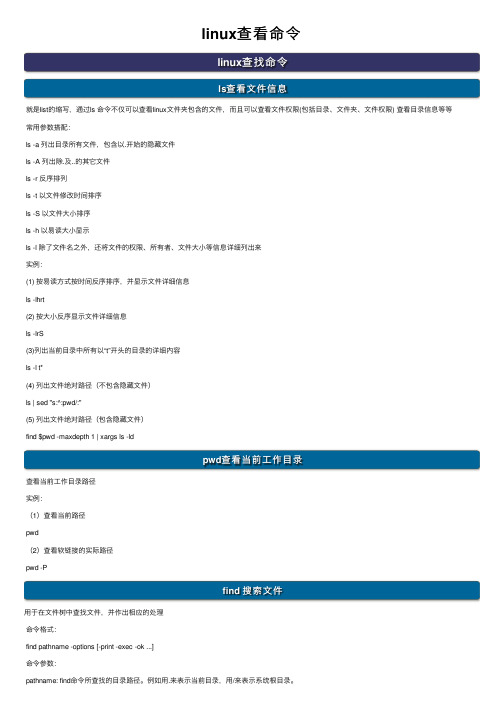
linux查看命令linux查找命令ls查看⽂件信息就是list的缩写,通过ls 命令不仅可以查看linux⽂件夹包含的⽂件,⽽且可以查看⽂件权限(包括⽬录、⽂件夹、⽂件权限) 查看⽬录信息等等常⽤参数搭配:ls -a 列出⽬录所有⽂件,包含以.开始的隐藏⽂件ls -A 列出除.及..的其它⽂件ls -r 反序排列ls -t 以⽂件修改时间排序ls -S 以⽂件⼤⼩排序ls -h 以易读⼤⼩显⽰ls -l 除了⽂件名之外,还将⽂件的权限、所有者、⽂件⼤⼩等信息详细列出来实例:(1) 按易读⽅式按时间反序排序,并显⽰⽂件详细信息ls -lhrt(2) 按⼤⼩反序显⽰⽂件详细信息ls -lrS(3)列出当前⽬录中所有以“t”开头的⽬录的详细内容ls -l t*(4) 列出⽂件绝对路径(不包含隐藏⽂件)ls | sed "s:^:pwd/:"(5) 列出⽂件绝对路径(包含隐藏⽂件)find $pwd -maxdepth 1 | xargs ls -ldpwd查看当前⼯作⽬录查看当前⼯作⽬录路径实例:(1)查看当前路径pwd(2)查看软链接的实际路径pwd -Pfind 搜索⽂件⽤于在⽂件树中查找⽂件,并作出相应的处理命令格式:find pathname -options [-print -exec -ok ...]命令参数:pathname: find命令所查找的⽬录路径。
例如⽤.来表⽰当前⽬录,⽤/来表⽰系统根⽬录。
-print: find命令将匹配的⽂件输出到标准输出。
-exec: find命令对匹配的⽂件执⾏该参数所给出的shell命令。
相应命令的形式为'command' { } ;,注意{ }和\;之间的空格。
-ok:和-exec的作⽤相同,只不过以⼀种更为安全的模式来执⾏该参数所给出的shell命令,在执⾏每⼀个命令之前,都会给出提⽰,让⽤户来确定是否执⾏。
Linux常用命令(3)--文件管理(查看文件大小权限信息、修改文件所属用户和操作权限、压。。。

Linux常⽤命令(3)--⽂件管理(查看⽂件⼤⼩权限信息、修改⽂件所属⽤户和操作权限、压。
⼀、查看⽂件⼤⼩、⽂件夹⼦⽬录1、查看⽂件系统磁盘⼤⼩、挂载点df :可以查看⼀级⽂件夹⼤⼩(默认单位为:k)、使⽤⽐例、档案系统及其挂⼊点(但对⽂件却⽆能为⼒)。
df -T :显⽰分区的⽂件系统(不带单位,默认为k;结果中包含分区⽂件类型Type)df -h :显⽰⽂件系统的可⽤空间及使⽤情形(采⽤⽤户易读的⽅式)概念解析:挂载点 Linux是树型⽬录结构,Linux只有⼀个根⽬录'/',其余各个⽬录都是基于这个根⽬录发散,就是树形结构。
Linux分区是将某个分区挂到⼀个对应的⽬录上。
例如/home对应⼀块分区,home⽬录就是这块分区的挂载点;/boot对应 虽然硬盘分区表中最多能存储四个分区,但我们实际使⽤时⼀般只分为两个分区,⼀个是主分区(Primary Partion)⼀个是扩展分区(extended partition)两种,主分区可以马上被使⽤但不能再分区,扩展分区必须再进⾏分区后才能使⽤,也就是说它必须还要进⾏⼆次分区。
那么由扩充分区再分下去的是什么呢?它就是逻辑分区(LogicalPartion),况且逻辑分区没有数量上限制。
Linux⽆论有⼏个分区,分给哪⼀⽬录使⽤,它归根结底就只有⼀个根⽬录,⼀个独⽴且唯⼀的⽂件结构。
每个分区都是⽤来组成整个⽂件系统的⼀部分,因为它采⽤了⼀种叫“挂载点”的处理⽅法,它的整个⽂件系统中包含了⼀整套的⽂件和⽬录,且将⼀个分区和⼀个⽬录联系起来。
这时要载⼊的⼀个分区将使它的存储空间在⼀个⽬录下获得。
Linux的分区是不同于其它操作系统的分区,它的分区格式常⽤的有Ext3和Swap两种,Ext3⽤于存放系统⽂件,Swap则作为交换分区(相当于windows中的虚拟内存⽂件)。
推荐阅读:概念解析:tmpfs tmpfs是⼀种虚拟内存⽂件系统,⽽不是块设备。
linux查看磁盘空间大小命令
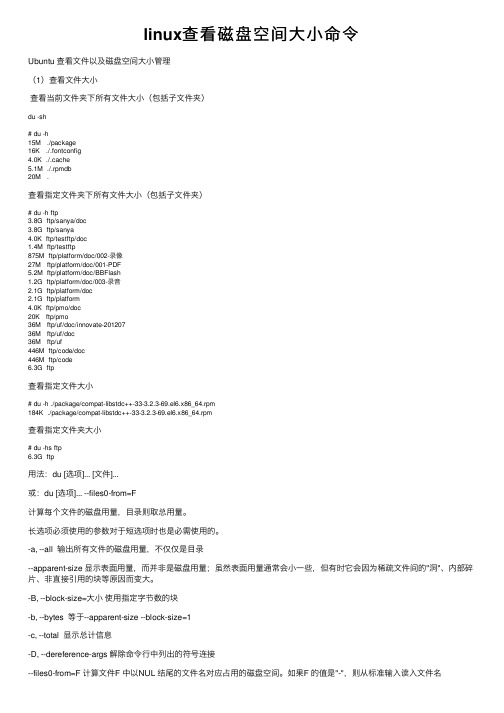
linux查看磁盘空间⼤⼩命令Ubuntu 查看⽂件以及磁盘空间⼤⼩管理(1)查看⽂件⼤⼩查看当前⽂件夹下所有⽂件⼤⼩(包括⼦⽂件夹)du -sh# du -h15M ./package16K ./.fontconfig4.0K ./.cache5.1M ./.rpmdb20M .查看指定⽂件夹下所有⽂件⼤⼩(包括⼦⽂件夹)# du -h ftp3.8G ftp/sanya/doc3.8G ftp/sanya4.0K ftp/testftp/doc1.4M ftp/testftp875M ftp/platform/doc/002-录像27M ftp/platform/doc/001-PDF5.2M ftp/platform/doc/BBFlash1.2G ftp/platform/doc/003-录⾳2.1G ftp/platform/doc2.1G ftp/platform4.0K ftp/pmo/doc20K ftp/pmo36M ftp/uf/doc/innovate-20120736M ftp/uf/doc36M ftp/uf446M ftp/code/doc446M ftp/code6.3G ftp查看指定⽂件⼤⼩# du -h ./package/compat-libstdc++-33-3.2.3-69.el6.x86_64.rpm184K ./package/compat-libstdc++-33-3.2.3-69.el6.x86_64.rpm查看指定⽂件夹⼤⼩# du -hs ftp6.3G ftp⽤法:du [选项]... [⽂件]...或:du [选项]... --files0-from=F计算每个⽂件的磁盘⽤量,⽬录则取总⽤量。
长选项必须使⽤的参数对于短选项时也是必需使⽤的。
-a, --all 输出所有⽂件的磁盘⽤量,不仅仅是⽬录--apparent-size 显⽰表⾯⽤量,⽽并⾮是磁盘⽤量;虽然表⾯⽤量通常会⼩⼀些,但有时它会因为稀疏⽂件间的"洞"、内部碎⽚、⾮直接引⽤的块等原因⽽变⼤。
Linux下du命令详解--查看文件和目录大小

Linux下du命令详解--查看⽂件和⽬录⼤⼩du 是 Disk Usage 的缩写, Linux 上最受欢迎的命令之⼀,它⽤来估算⽂件或⽬录占⽤的磁盘空间, 它也是很基础的命令,使⽤Linux的⼈都应该掌握它的⽤法du 命令及语法Usage: du [OPTION]... [FILE]...du [OPTION]... --files0-from=F常⽤的选项如下:-a: 显⽰⽬录中所有⽂件以及⽂件夹⼤⼩-h: 以 Kb、Mb 、Gb 等易读的单位显⽰⼤⼩--si: 类似 -h 选项,但是计算是⽤ 1000 为基数⽽不是1024-s: 显⽰⽬录总⼤⼩-d: 是 --max-depth=N 选项的简写,表⽰深⼊到第⼏层⽬录,超过指定层数⽬录则忽略-c: 除了显⽰⽬录⼤⼩外,额外⼀⾏显⽰总占⽤量--time: 显⽰每⼀个⽬录下最近修改⽂件的时间-t: 是 --threshold=SIZE 的简写,过滤掉⼩于 SIZE ⼤⼩的⽂件以及⽬录--exclude=PATTERN:过滤与 PATTERN 匹配的⽂件名或者⽬录名显⽰所有⽬录及⽂件⼤⼩下⾯的例⼦显⽰了所有⽬录以及⽬录下⽂件的⼤⼩,单位默认是 Kb[root@ecs-centos-7 tt]# du -a temp/4 temp/suba.txt4 temp/test/abc.txt4 temp/test/ha/ha.txt8 temp/test/ha16 temp/test4 temp/time.txt28 temp/注意: 上⾯的例⼦如果不使⽤ -a 选项,默认情况下只显⽰⽬录⼤⼩,不显⽰⽂件⼤⼩。
即执⾏du temp/ 只会显⽰⽬录⼤⼩,请看以下的例⼦:[root@ecs-centos-7 tt]# du temp8 temp/test/ha16 temp/test28 temp以易读的⽅式显⽰默认显⽰的⼤⼩只有⼀个孤零零的数字,连单位也没有,让⼈第⼀眼看上去有点疑惑,通过 -h 选项可以让⼤⼩显⽰成⼈类易读的⽅式,这个选项应该是最常⽤的了[root@ecs-centos-7 tt]# du -b temp/4117 temp/test/ha8218 temp/test12326 temp/[root@ecs-centos-7 tt]# du -h temp/8.0K temp/test/ha16K temp/test28K temp/[root@ecs-centos-7 tt]# du --si temp/8.2k temp/test/ha17k temp/test29k temp/上⾯的例⼦中, -h 选项默认计算基数是 1024 , --si 选项默认计算基数是 1000所以temp/test/ha⽬录以 -h 选项计算的⼤⼩是 8.0K,⽽以 --si 选项计算的⼤⼩是 8.2K-h 以及 --si 选项的⼤⼩单位随着⽬录及⽂件的⼤⼩⾃动的调整⽬录总⼤⼩有时我们只需要知道⼀个⽬录的总⼤⼩,不需要知道⼦⽬录及⼦⽬录下⽂件的⼤⼩,可以通过 -s 选项获取⽬录总⼤⼩[root@ecs-centos-7 tt]# du -sh .72K .[root@ecs-centos-7 tt]# du -sh temp/28K temp/上⾯的例⼦分别获取当前⽬录的总⼤⼩以及 temp/ ⽬录的总⼤⼩通过 -c 选项也能获取⽬录总⼤⼩,不过它先显⽰⼦⽬录⼤⼩,最后⼀⾏显⽰总⼤⼩,下⾯例⼦最后⼀⾏ total 字符串前⾯的 28K 表⽰ temp/ ⽬录的总⼤⼩[root@ecs-centos-7 tt]# du -ch temp/8.0K temp/test/ha16K temp/test28K temp/28K total指定⽬录深度如果⼀个⽬录有很多⼦⽬录,只想显⽰指定层数⽬录⼤⼩的话,可以使⽤ -d 选项实现temp/ 的⼦⽬录结构如下:[root@ecs-centos-7 tt]# tree -d temp/temp/└── test└── ha2 directories指定⽬录深度[root@ecs-centos-7 tt]# du -d 0 temp/28 temp/[root@ecs-centos-7 tt]# du -d 1 temp/16 temp/test28 temp/[root@ecs-centos-7 tt]# du --max-depth=2 temp/8 temp/test/ha16 temp/test28 temp/du -d 0 temp/: 显⽰第0层⽬录,也即当前⽬录总⼤⼩,此时相当于 -s 选项du -d 1 temp/: 显⽰第1层⽬录,也即 temp/test ⽬录的总⼤⼩du --max-depth=2 temp/: 显⽰第2层⽬录,也即 temp/test/ha ⽬录总⼤⼩显⽰最近修改时间[root@ecs-centos-7 tt]# du --time temp8 2020-07-21 20:11 temp/test/ha16 2020-07-21 20:11 temp/test28 2020-07-21 20:13 temp上⾯的例⼦中显⽰了每个⽬录最近修改时间,时间的粒度只精确到分钟如果想显⽰粒度更细些的话,可以⽤ --time-syle=STYLE 选项来指定时间的输出格式,其中 STYLE 表⽰⽇期的格式化输出字符串,和 date 命令的格式化输出的格式⼀样的例1:显⽰ UTC 时间的秒数(从1970年1⽉1⽇到现在的秒数)[root@ecs-centos-7 tt]# du --time --time-style="+%s" temp/8 1595333498 temp/test/ha16 1595333514 temp/test28 1595333582 temp/例2:显⽰完整的年⽉⽇时分秒[root@ecs-centos-7 tt]# du --time --time-style="+%F %T" temp/8 2020-07-21 20:11:38 temp/test/ha16 2020-07-21 20:11:54 temp/test28 2020-07-21 20:13:02 temp/按照⼤⼩过滤从显⽰的结果中,过滤掉指定⼤⼩的⽬录以及⽂件[root@ecs-centos-7 tt]# du -b temp/4117 temp/test/ha8218 temp/test12326 temp/[root@ecs-centos-7 tt]# du -b -t 4118 temp/8218 temp/test12326 temp/上⾯的例⼦中,过滤掉⼩于 4118 bytes 的⽬录按照⽬录名或⽂件名过滤假如⼀个⽬录下⼦⽬录太多,我们可以根据⼦⽬录名或者⽂件名和指定的模式串匹配,从⽽过滤掉匹配上的⽬录和⽂件[root@ecs-centos-7 tt]# du -a temp4 temp/suba.txt4 temp/test/abc.txt4 temp/test/ha/ha.txt8 temp/test/ha16 temp/test4 temp/time.txt28 temp[root@ecs-centos-7 tt]# du -a --exclude=*a* temp/4 temp/test4 temp/time.txt12 temp/上⾯的例⼦中, 过滤的模式串是: *a*它表⽰过滤掉⽬录名或者⽂件名中含有字符 a的⽬录或⽂件,例⼦中前⾯四⾏的⽬录或⽂件名中都包含了 a字符,所以都被过滤掉了占满磁盘的都是什么⽂件开发者经常遇到的问题是磁盘满了,这时我们可以组合使⽤ du 和 sort 来查出 “元凶”,使⽤sort -hr进⾏倒序排序当前⽬录下⽂件从⼤到⼩排序[root@ecs-centos-7 tt]# du -sh temp/* | sort -hr10M temp/clpay.tar16K temp/test4.0K temp/time.txt4.0K temp/lnsuba当前⽬录以及⼦⽬录从⼤到⼩排序[root@ecs-centos-7 tt]# du -ah temp/* | sort -hr10M temp/clpay.tar16K temp/test8.0K temp/test/ha4.0K temp/time.txt4.0K temp/test/ha/ha.txt4.0K temp/test/abc.txt4.0K temp/lnsuba磁盘占⽤最⼤的三个⽬录以及⼦⽬录[root@ecs-centos-7 tt]# du -ah temp/* | sort -hr | head -n 310M temp/clpay.tar16K temp/test8.0K temp/test/ha通过上⾯介绍的⼏种⽅式可以找出指定⽬录中哪些⽂件或⽬录占⽤磁盘空间⽐较⼤,清理的时候优先清理它们。
linux中du命令的详细解释
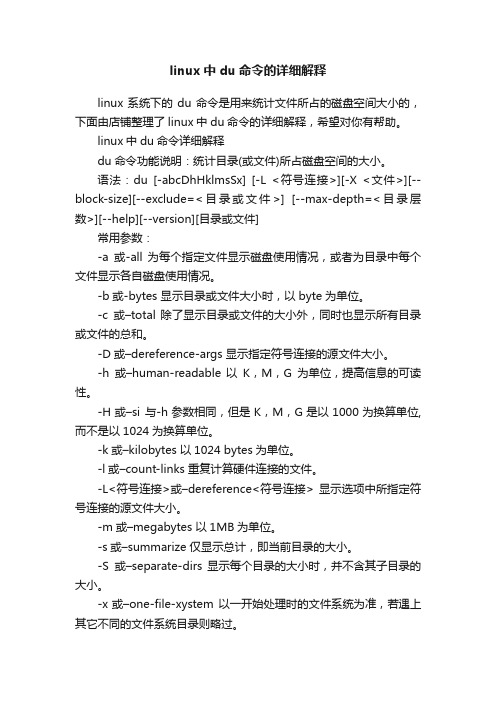
linux中du命令的详细解释linux系统下的du命令是用来统计文件所占的磁盘空间大小的,下面由店铺整理了linux中du命令的详细解释,希望对你有帮助。
linux中du命令详细解释du命令功能说明:统计目录(或文件)所占磁盘空间的大小。
语法:du [-abcDhHklmsSx] [-L <符号连接>][-X <文件>][--block-size][--exclude=<目录或文件>] [--max-depth=<目录层数>][--help][--version][目录或文件]常用参数:-a或-all 为每个指定文件显示磁盘使用情况,或者为目录中每个文件显示各自磁盘使用情况。
-b或-bytes 显示目录或文件大小时,以byte为单位。
-c或–total 除了显示目录或文件的大小外,同时也显示所有目录或文件的总和。
-D或–dereference-args 显示指定符号连接的源文件大小。
-h或–human-readable 以K,M,G为单位,提高信息的可读性。
-H或–si 与-h参数相同,但是K,M,G是以1000为换算单位,而不是以1024为换算单位。
-k或–kilobytes 以1024 bytes为单位。
-l或–count-links 重复计算硬件连接的文件。
-L<符号连接>或–dereference<符号连接> 显示选项中所指定符号连接的源文件大小。
-m或–megabytes 以1MB为单位。
-s或–summarize 仅显示总计,即当前目录的大小。
-S或–separate-dirs 显示每个目录的大小时,并不含其子目录的大小。
-x或–one-file-xystem 以一开始处理时的文件系统为准,若遇上其它不同的文件系统目录则略过。
-X<文件>或–exclude-from=<文件> 在<文件>指定目录或文件。
linux的du命令
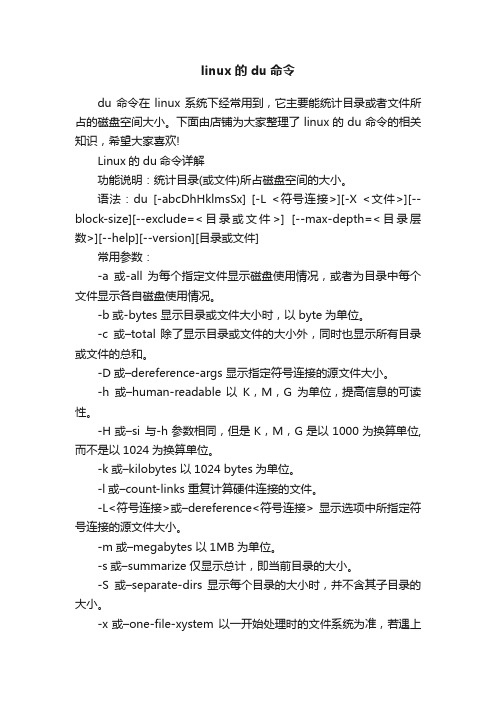
linux的du命令du命令在linux系统下经常用到,它主要能统计目录或者文件所占的磁盘空间大小。
下面由店铺为大家整理了linux的du命令的相关知识,希望大家喜欢!Linux的du命令详解功能说明:统计目录(或文件)所占磁盘空间的大小。
语法:du [-abcDhHklmsSx] [-L <符号连接>][-X <文件>][--block-size][--exclude=<目录或文件>] [--max-depth=<目录层数>][--help][--version][目录或文件]常用参数:-a或-all 为每个指定文件显示磁盘使用情况,或者为目录中每个文件显示各自磁盘使用情况。
-b或-bytes 显示目录或文件大小时,以byte为单位。
-c或–total 除了显示目录或文件的大小外,同时也显示所有目录或文件的总和。
-D或–dereference-args 显示指定符号连接的源文件大小。
-h或–human-readable 以K,M,G为单位,提高信息的可读性。
-H或–si 与-h参数相同,但是K,M,G是以1000为换算单位,而不是以1024为换算单位。
-k或–kilobytes 以1024 bytes为单位。
-l或–count-links 重复计算硬件连接的文件。
-L<符号连接>或–dereference<符号连接> 显示选项中所指定符号连接的源文件大小。
-m或–megabytes 以1MB为单位。
-s或–summarize 仅显示总计,即当前目录的大小。
-S或–separate-dirs 显示每个目录的大小时,并不含其子目录的大小。
-x或–one-file-xystem 以一开始处理时的文件系统为准,若遇上其它不同的文件系统目录则略过。
-X<文件>或–exclude-from=<文件> 在<文件>指定目录或文件。
[Linux小技巧]查看文件夹大小及所属用户组
![[Linux小技巧]查看文件夹大小及所属用户组](https://img.taocdn.com/s3/m/86989ec277eeaeaad1f34693daef5ef7ba0d1227.png)
[Linux⼩技巧]查看⽂件夹⼤⼩及所属⽤户组⼀、linux中查看⽂件夹⼤⼩及所属⽤户组——du和ls命令参数的⽤法du命令使⽤⽰例:1> 要显⽰⼀个⽬录树及其每个⼦树的磁盘使⽤情况du -h /home/linux#-h ⾃动根据⼤⼩以k、m、g为单位显⽰,提⾼信息的可读性。
kb、mb、gb是以1024为换算单位, -h以1000为换算单位;#若省略/home/linux路径⽬录,则显⽰当前⽬录的;du -sh /home/linux#-s 仅显⽰总计,即显⽰路径⽬录或当前⽬录的总⼤⼩。
2>查看当前⽬录下所有⽬录以及⼦⽬录的⼤⼩:du -h .#“.”代表当前⽬录下。
也可以换成⼀个明确的路径#-h表⽰⾃动⽤K、M、G的⼈性化形式显⽰3>查看当前⽬录下user⽬录的⼤⼩,并不想看其他⽬录以及其⼦⽬录:du -sh user#-s表⽰总结的意思,即只列出⼀个总结的值du -h –max-depth=0 user–max-depth=n表⽰只深⼊到第n层⽬录,此处设置为0,即表⽰不深⼊到⼦⽬录。
4>列出user⽬录及其⼦⽬录下所有⽬录和⽂件的⼤⼩:du -ah user#-a表⽰包括⽬录和⽂件5>列出当前⽬录中的⽬录名不包括xyz字符串的⽬录的⼤⼩:du -h –exclude=’*xyz*’6>想在⼀个屏幕下列出更多的关于user⽬录及⼦⽬录⼤⼩的信息:du -0h user#-0(杠零)表⽰每列出⼀个⽬录的信息,不换⾏,⽽是直接输出下⼀个⽬录的信息。
=========================================================================Du命令功能说明:统计⽬录(或⽂件)所占磁盘空间的⼤⼩。
语 法:du [-abcDhHklmsSx] [-L <符号连接>][-X <⽂件>][--block-size][--exclude=<⽬录或⽂件>] [--max-depth=<⽬录层数>][--help][--version][⽬录或⽂件]常⽤参数:-a或-all 为每个指定⽂件显⽰磁盘使⽤情况,或者为⽬录中每个⽂件显⽰各⾃磁盘使⽤情况。
Linux中如何查找最大的10个文件方法

Linux中如何查找最大的10个文件方法有时我们需要在Linux下查找文件哪个最大,便于管理,这篇文章主要给大家介绍了关于在Linux中如何查找最大的10个文件的一些方法,文中分别给大家介绍了四种方法需要的朋友们下面随着小编来一起学习学习吧。
方法 1在Linux 中没有特定的命令可以直接执行此操作,因此我们需要将多个命令结合使用。
# find / -type f -print0 | xargs -0 du -h | sort -rh | head -n 101.4G /swapfile1.1G /home/magi/ubuntu-17.04-desktop-amd64.iso564M/home/magi/.gdfuse/magi/cache/0B5nso_FPaZFqTFU0XzkzUlJU ZzA378M/home/magi/.gdfuse/magi/cache/0B5nso_FPaZFqeldzUmhPeC0 3Zm8377M/home/magi/.gdfuse/magi/cache/0B5nso_FPaZFqRGd4V0VrOX M4YVU100M /usr/lib/x86_64-linux-gnu/libOxideQtCore.so.093M /usr/lib/firefox/libxul.so84M /var/lib/snapd/snaps/core_3604.snap84M /var/lib/snapd/snaps/core_3440.snap84M /var/lib/snapd/snaps/core_3247.snap详解:find:在目录结构中搜索文件的命令/:在整个系统(从根目录开始)中查找-type:指定文件类型f:普通文件-print0:在标准输出显示完整的文件名,其后跟一个空字符(null) |:控制操作符,将一条命令的输出传递给下一个命令以供进一步处理xargs:将标准输入转换成命令行参数的命令-0:以空字符(null)而不是空白字符(LCTT 译者注:即空格、制表符和换行)来分割记录du -h:以可读格式计算磁盘空间使用情况的命令sort:对文本文件进行排序的命令-r:反转结果-h:用可读格式打印输出head:输出文件开头部分的命令n -10:打印前 10 个文件方法 2这是查找 Linux 系统中最大的前 10 个文件的另一种方法。
Linux命令行中的文件和大小查看技巧
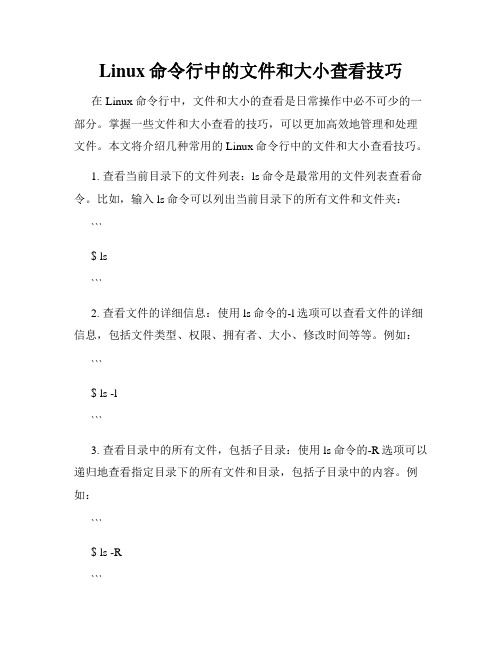
Linux命令行中的文件和大小查看技巧在Linux命令行中,文件和大小的查看是日常操作中必不可少的一部分。
掌握一些文件和大小查看的技巧,可以更加高效地管理和处理文件。
本文将介绍几种常用的Linux命令行中的文件和大小查看技巧。
1. 查看当前目录下的文件列表:ls命令是最常用的文件列表查看命令。
比如,输入ls命令可以列出当前目录下的所有文件和文件夹:```$ ls```2. 查看文件的详细信息:使用ls命令的-l选项可以查看文件的详细信息,包括文件类型、权限、拥有者、大小、修改时间等等。
例如:```$ ls -l```3. 查看目录中的所有文件,包括子目录:使用ls命令的-R选项可以递归地查看指定目录下的所有文件和目录,包括子目录中的内容。
例如:```$ ls -R```4. 查看文件的大小:使用ls命令的-h选项可以以人类可读的格式显示文件的大小。
这样可以更直观地了解文件的大小。
例如:```$ ls -lh```5. 查看当前目录下的所有文件和文件夹的大小总和:使用du命令可以查看当前目录下的所有文件和文件夹的大小总和。
例如:```$ du -sh```6. 查看目录中所有文件和文件夹的大小:使用du命令的-a选项可以查看指定目录下的所有文件和文件夹的大小。
例如:```$ du -sh *```7. 查看文件的内容:使用cat命令可以查看文本文件的内容。
例如,输入以下命令查看hello.txt文件的内容:```$ cat hello.txt```8. 查看文件的部分内容:使用head和tail命令可以查看文件的前几行和后几行内容。
例如,输入以下命令分别查看文件的前5行和后5行内容:```$ head -n 5 filename$ tail -n 5 filename```9. 查看文件的行数、字数和字符数:使用wc命令可以统计文件的行数、字数和字符数。
例如,输入以下命令可以统计文件test.txt的行数、字数和字符数:```$ wc test.txt```10. 查看文件的权限:使用ls命令的-l选项可以查看文件的权限。
linux常用命令大全,常用的linux命令有哪些
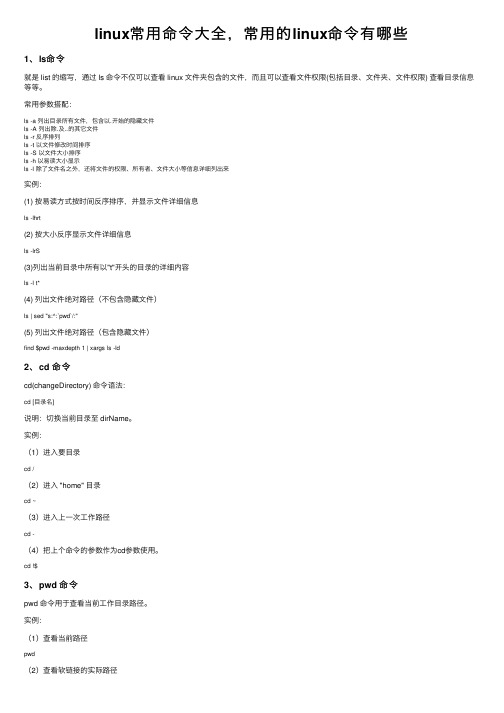
linux常⽤命令⼤全,常⽤的linux命令有哪些1、ls命令就是 list 的缩写,通过 ls 命令不仅可以查看 linux ⽂件夹包含的⽂件,⽽且可以查看⽂件权限(包括⽬录、⽂件夹、⽂件权限) 查看⽬录信息等等。
常⽤参数搭配:ls -a 列出⽬录所有⽂件,包含以.开始的隐藏⽂件ls -A 列出除.及..的其它⽂件ls -r 反序排列ls -t 以⽂件修改时间排序ls -S 以⽂件⼤⼩排序ls -h 以易读⼤⼩显⽰ls -l 除了⽂件名之外,还将⽂件的权限、所有者、⽂件⼤⼩等信息详细列出来实例:(1) 按易读⽅式按时间反序排序,并显⽰⽂件详细信息ls -lhrt(2) 按⼤⼩反序显⽰⽂件详细信息ls -lrS(3)列出当前⽬录中所有以"t"开头的⽬录的详细内容ls -l t*(4) 列出⽂件绝对路径(不包含隐藏⽂件)ls | sed "s:^:`pwd`/:"(5) 列出⽂件绝对路径(包含隐藏⽂件)find $pwd -maxdepth 1 | xargs ls -ld2、cd 命令cd(changeDirectory) 命令语法:cd [⽬录名]说明:切换当前⽬录⾄ dirName。
实例:(1)进⼊要⽬录cd /(2)进⼊ "home" ⽬录cd ~(3)进⼊上⼀次⼯作路径cd -(4)把上个命令的参数作为cd参数使⽤。
cd !$3、pwd 命令pwd 命令⽤于查看当前⼯作⽬录路径。
实例:(1)查看当前路径pwd(2)查看软链接的实际路径4、mkdir 命令mkdir 命令⽤于创建⽂件夹。
可⽤选项:-m: 对新建⽬录设置存取权限,也可以⽤ chmod 命令设置;-p: 可以是⼀个路径名称。
此时若路径中的某些⽬录尚不存在,加上此选项后,系统将⾃动建⽴好那些尚不在的⽬录,即⼀次可以建⽴多个⽬录。
实例:(1)当前⼯作⽬录下创建名为 t的⽂件夹mkdir t(2)在 tmp ⽬录下创建路径为 test/t1/t 的⽬录,若不存在,则创建:mkdir -p /tmp/test/t1/t5、rm 命令删除⼀个⽬录中的⼀个或多个⽂件或⽬录,如果没有使⽤ -r 选项,则 rm 不会删除⽬录。
linux ls命令参数及使用方法详解
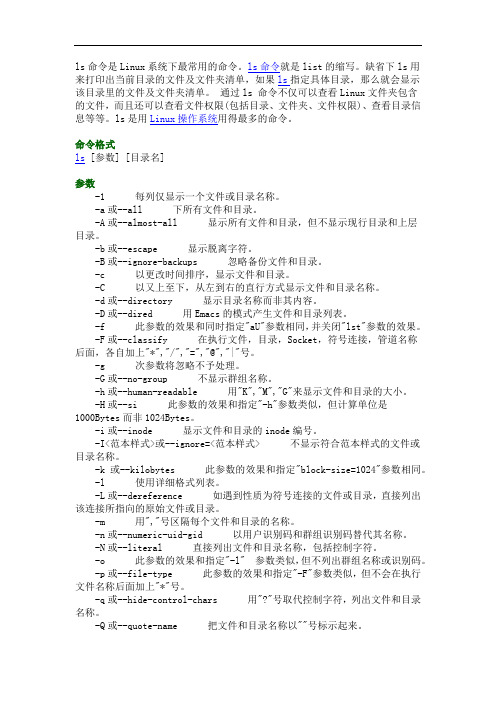
ls命令是Linux系统下最常用的命令。
ls命令就是list的缩写。
缺省下ls用来打印出当前目录的文件及文件夹清单,如果ls指定具体目录,那么就会显示该目录里的文件及文件夹清单。
通过ls 命令不仅可以查看Linux文件夹包含的文件,而且还可以查看文件权限(包括目录、文件夹、文件权限)、查看目录信息等等。
ls是用Linux操作系统用得最多的命令。
命令格式ls [参数] [目录名]参数-1 每列仅显示一个文件或目录名称。
-a或--all 下所有文件和目录。
-A或--almost-all 显示所有文件和目录,但不显示现行目录和上层目录。
-b或--escape 显示脱离字符。
-B或--ignore-backups 忽略备份文件和目录。
-c 以更改时间排序,显示文件和目录。
-C 以又上至下,从左到右的直行方式显示文件和目录名称。
-d或--directory 显示目录名称而非其内容。
-D或--dired 用Emacs的模式产生文件和目录列表。
-f 此参数的效果和同时指定"aU"参数相同,并关闭"lst"参数的效果。
-F或--classify 在执行文件,目录,Socket,符号连接,管道名称后面,各自加上"*","/","=","@","|"号。
-g 次参数将忽略不予处理。
-G或--no-group 不显示群组名称。
-h或--human-readable 用"K","M","G"来显示文件和目录的大小。
-H或--si 此参数的效果和指定"-h"参数类似,但计算单位是1000Bytes而非1024Bytes。
-i或--inode 显示文件和目录的inode编号。
-I<范本样式>或--ignore=<范本样式> 不显示符合范本样式的文件或目录名称。
linux上查看磁盘大小的命令
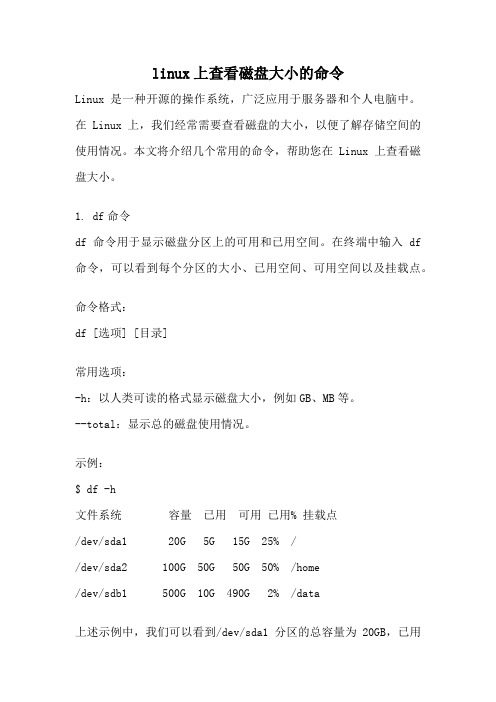
linux上查看磁盘大小的命令Linux是一种开源的操作系统,广泛应用于服务器和个人电脑中。
在Linux上,我们经常需要查看磁盘的大小,以便了解存储空间的使用情况。
本文将介绍几个常用的命令,帮助您在Linux上查看磁盘大小。
1. df命令df命令用于显示磁盘分区上的可用和已用空间。
在终端中输入df 命令,可以看到每个分区的大小、已用空间、可用空间以及挂载点。
命令格式:df [选项] [目录]常用选项:-h:以人类可读的格式显示磁盘大小,例如GB、MB等。
--total:显示总的磁盘使用情况。
示例:$ df -h文件系统容量已用可用已用% 挂载点/dev/sda1 20G 5G 15G 25% //dev/sda2 100G 50G 50G 50% /home/dev/sdb1 500G 10G 490G 2% /data上述示例中,我们可以看到/dev/sda1分区的总容量为20GB,已用空间为5GB,可用空间为15GB,已用百分比为25%。
2. du命令du命令用于计算目录或文件的磁盘使用情况。
在终端中输入du命令,可以查看指定目录或文件的磁盘使用情况。
命令格式:du [选项] [目录或文件]常用选项:-h:以人类可读的格式显示磁盘使用情况。
-s:仅显示总的磁盘使用情况,不显示每个子目录的使用情况。
示例:$ du -h /home3.5G /home/user12.2G /home/user25.7G /home上述示例中,我们可以看到/home目录下每个子目录的磁盘使用情况,以及总的磁盘使用情况。
3. ls命令ls命令用于列出目录中的文件和子目录。
在终端中输入ls命令,可以查看指定目录中的文件和子目录的大小。
命令格式:ls [选项] [目录]常用选项:-l:以长格式显示文件和目录的详细信息,包括文件大小。
示例:$ ls -l /data-rw-r--r-- 1 user1 user1 2.0G file1.txt-rw-r--r-- 1 user1 user1 1.5G file2.txtdrwxr-xr-x 2 user1 user1 4.0K dir1上述示例中,我们可以看到/data目录下的文件file1.txt大小为2.0GB,文件file2.txt大小为1.5GB,目录dir1大小为4.0KB。
linux查看某个目录下文件的数量
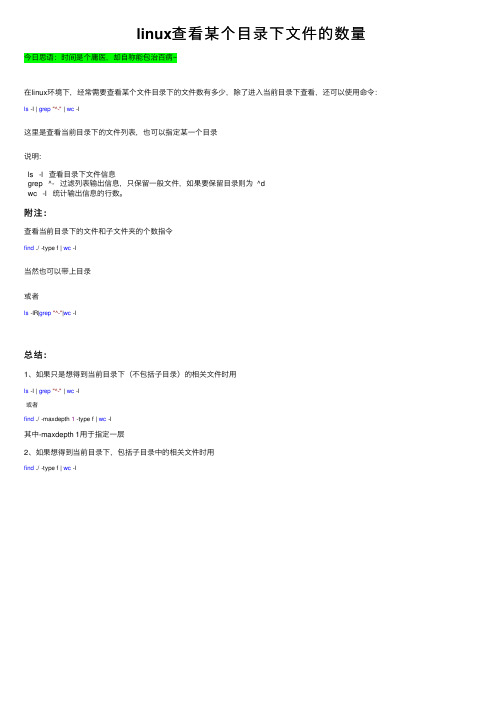
linux查看某个⽬录下⽂件的数量今⽇思语:时间是个庸医,却⾃称能包治百病~
在linux环境下,经常需要查看某个⽂件⽬录下的⽂件数有多少,除了进⼊当前⽬录下查看,还可以使⽤命令:ls -l | grep"^-" | wc -l
这⾥是查看当前⽬录下的⽂件列表,也可以指定某⼀个⽬录
说明:
ls -l 查看⽬录下⽂件信息
grep ^- 过滤列表输出信息,只保留⼀般⽂件,如果要保留⽬录则为 ^d
wc -l 统计输出信息的⾏数。
附注:
查看当前⽬录下的⽂件和⼦⽂件夹的个数指令
find ./ -type f | wc -l
当然也可以带上⽬录
或者
ls -lR|grep"^-"|wc -l
总结:
1、如果只是想得到当前⽬录下(不包括⼦⽬录)的相关⽂件时⽤
ls -l | grep"^-" | wc -l
或者
find ./ -maxdepth 1 -type f | wc -l
其中-maxdepth 1⽤于指定⼀层
2、如果想得到当前⽬录下,包括⼦⽬录中的相关⽂件时⽤
find ./ -type f | wc -l。
- 1、下载文档前请自行甄别文档内容的完整性,平台不提供额外的编辑、内容补充、找答案等附加服务。
- 2、"仅部分预览"的文档,不可在线预览部分如存在完整性等问题,可反馈申请退款(可完整预览的文档不适用该条件!)。
- 3、如文档侵犯您的权益,请联系客服反馈,我们会尽快为您处理(人工客服工作时间:9:00-18:30)。
du -sh 文件或目录名
用法:du [选项]... [文件]...
总结每个<文件>的磁盘用量,目录则取总用量。
长选项必须用的参数在使用短选项时也是必须的。
-a, --all write counts for all files, not just directories
-B, --block-size=SIZE use SIZE-byte blocks
-b, --bytes print size in bytes
-c, --total produce a grand total
-D, --dereference-args dereference FILEs that are symbolic links
-h, --human-readable 以容易理解的格式印出文件大小 (例如 1K 234M 2G)
-H, --si 类似 -h,但取 1000 的次方而不是 1024
-k 即 --block-size=1K
-l, --count-links 连硬链接的大小也计算在内
-L, --dereference 找出任何符号链接指示的真正目的地
-S, --separate-dirs 不包括子目录的占用量
-s, --summarize 只分别计算命令列中每个参数所占的总用量
-x, --one-file-system skip directories on different filesystems
-X FILE, --exclude-from=FILE Exclude files that match any pattern in FILE. --exclude=PATTERN Exclude files that match PATTERN.
--max-depth=N print the total for a directory (or file, with --all)
only if it is N or fewer levels below the command
line argument; --max-depth=0 is the same as
--summarize。
